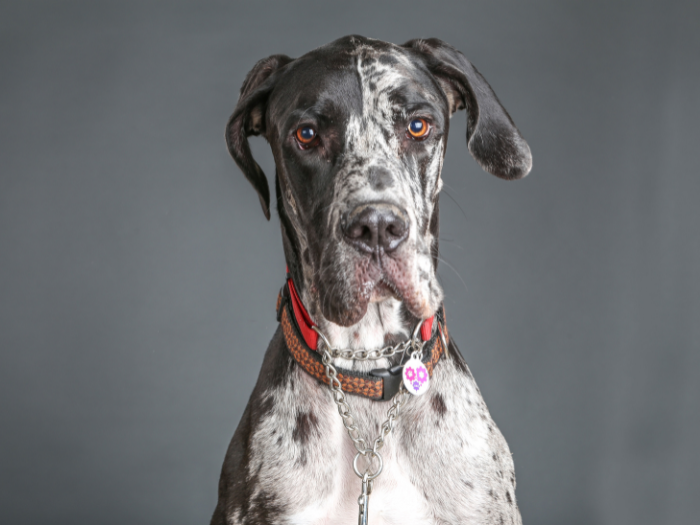
History and Origins: From Ancient Guardians to Beloved Companions
History: Great Danes have a rich history that dates back centuries. Originally bred in Germany, they were primarily used for hunting wild boars and guarding estates. Over time, they transitioned into the role of beloved family companions due to their gentle temperament and loyalty.
Breed Standards and Physical Appearance:
Impressive Stature: Great Danes are known for their impressive size and elegant appearance. They are one of the largest dog breeds, with males standing at 30 to 34 inches (76 to 86 cm) tall at the shoulder and weighing between 140 to 175 pounds (63 to 79 kg). Females are slightly smaller but still substantial in size. Their well-muscled bodies, deep chests, and noble expressions make them truly magnificent.
Coat and Colors: Great Danes have a short and smooth coat that is easy to maintain. They come in various colors, including fawn, brindle, blue, black, harlequin, and mantle. Each color variation adds to their individuality and charm.
Temperament and Personality Traits:
Gentle Giants: Despite their size, Great Danes have a gentle and affectionate nature. They are known for their loving and loyal personalities, making them excellent family pets. They are patient with children and often become their dedicated protectors.
Intelligence and Training: Great Danes are intelligent dogs and respond well to positive reinforcement training methods. Early socialization and consistent training are crucial to ensure they become well-behaved and obedient companions. Due to their large size, it’s important to establish clear boundaries and manners from a young age.
Caring for Great Danes:
Exercise and Physical Needs: Great Danes may be gentle at heart, but they still require regular exercise to keep them happy and healthy. Daily walks and play sessions in a secure, spacious area are essential. However, it’s important to be mindful of their joints and avoid excessive exercise during their growth phase to prevent potential health issues.
Nutrition and Feeding: Great Danes have unique nutritional needs due to their size and rapid growth rate. A high-quality diet specifically formulated for large breeds is recommended to support their joint health and overall well-being. Consult with your veterinarian to determine the appropriate feeding regimen for your Great Dane.
Grooming and Health Care: Despite their short coat, Great Danes do shed. Regular brushing helps to minimize loose hair and keep their coat healthy. Additionally, their ears should be checked and cleaned regularly to prevent infections. Routine veterinary care, including vaccinations, dental cleanings, and health screenings, is vital to ensure their long-term health.
Practical Tips and Considerations:
Space Requirements: Great Danes require ample space to move and stretch their legs comfortably. Living in a home with a securely fenced yard or providing regular access to safe and spacious outdoor areas is essential.
Socialization and Training: Early socialization is key to ensuring that Great Danes grow up to be well-rounded and confident dogs. Expose them to various environments, people, and animals to help them develop good social skills. Training should be positive, consistent, and focused on reinforcing desirable behaviors.
Health Considerations: Great Danes are prone to certain health issues, including hip dysplasia, bloat, and heart problems. Regular veterinary check-ups and prompt attention to any signs of discomfort or illness are essential for early detection and intervention.
Conclusion:
Great Danes are magnificent and gentle giants that bring joy and companionship to their families. By understanding their history, unique physical characteristics, temperament, and specific care requirements, you can provide them with the love, attention, and care they deserve. With proper training, socialization, and veterinary care, Great Danes can be exceptional family pets and lifelong companions.
